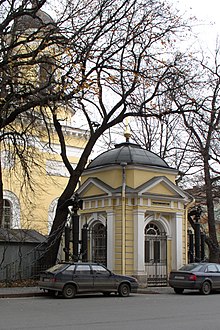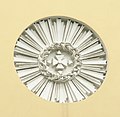Transfiguration Cathedral (Saint Petersburg)
This article relies largely or entirely on a single source. (December 2014) |

Transfiguration Cathedral (official name:
The church has given names to both Transfiguration Square and a nearby lane, which was formerly known as Church Lane (Russian: Церковный переулок) and is now known as Radishchev Lane (Russian: переулок Радищева).
History
Construction of the cathedral was ordered by empress
During the reign of the emperor Paul I, the regimental Transfiguration Cathedral received the honorary title "of all the Guards", November 12, 1796.
August 8 (August 20, New Style), 1825, the first Transfiguration Cathedral was lost to fire. All that remained of the cathedral were the exterior walls and the essential sacred objects, which had been saved.
Between 1825 and 1829 it was rebuilt by architect
A parish charitable society began at the cathedral in 1871, maintaining an almshouse, a children's shelter, a cafeteria, a school for children of soldiers, and free living quarters. In 1912, it was joined by a Brotherhood of Sobriety and Chastity. On the holy day of the Transfiguration of Christ (popular name - the Apple Savior), which occurs 6 August (Old Style), the cathedral has traditionally hosted a fruit bazaar.
After the 1917
From 1922 to 1926 (under
The façades and interior were restored between 1946 and 1948.
-
Western portico
-
A column capital
-
The main dome
-
Bell tower and clock
-
Panel with military imagery
-
Bas-relief decoration
Fence


Stasov directed construction of a fence around the cathedral in 1832-1833 commemorating the victory in the
The fence consists of 102 bronze cannon barrels, in groups of three, set on thirty-four granite bases. They are set with the muzzles facing downwards to signify they will never again be used in combat. The central barrel of each grouping is topped with a crowned double-headed eagle. The barrel groups are linked by massive decorative chains. The two main gates are decorated with shields with bronze depictions of the medals presented for the war. Also, around the cathedral stand twelve cannons and two Unicorn (long-barreled) cannons, which are the property of the Preobrazhensky regiment.
In 1886, architect Ivan Blazheyevich Slupsky designed a chapel built into the fence. In 1916, architect Sergei Osipovich Ovsyannikov planned construction of a burial-vault for the burial of officers fallen in World War I, but the project was never realized.
-
Main gate
-
Medals on the two sides of the main gate
-
Central decoration on the main gate
-
Double-headed eagle on one of the barrels
Relics and Holy Objects
In a side chapel near the north wall of the church is a hinged icon with depictions of the Transfiguration of Christ, the martyr
The cathedral houses the regimental relics, war trophies, and bronze wall plaques with the names of officers of the Preobrazhensky regiment fallen in battle. Under glass in separate cases are the Preobrazhensky uniforms of Alexander I, Nicholas I, and Alexander II, as well as a blood-stained saber that Alexander II was wearing during an attempt on his life on March 13, 1881 (March 1, O.S.).
References
- ^ a b "Спасо-Преображенский собор (Transfiguration Cathedral)". Saint Petersburg Encyclopedia (in Russian). Retrieved 2008-03-04.
External links
![]() Media related to Transfiguration Cathedral (Saint Petersburg) at Wikimedia Commons
Media related to Transfiguration Cathedral (Saint Petersburg) at Wikimedia Commons










